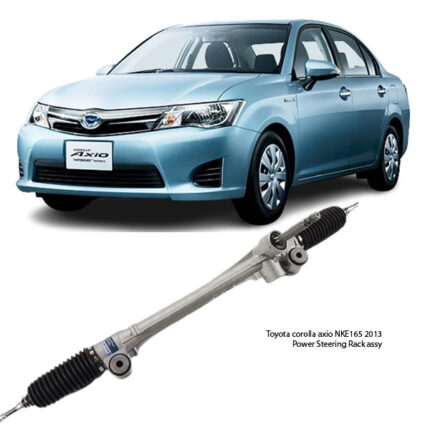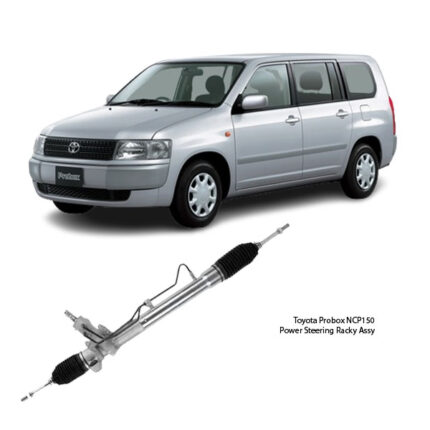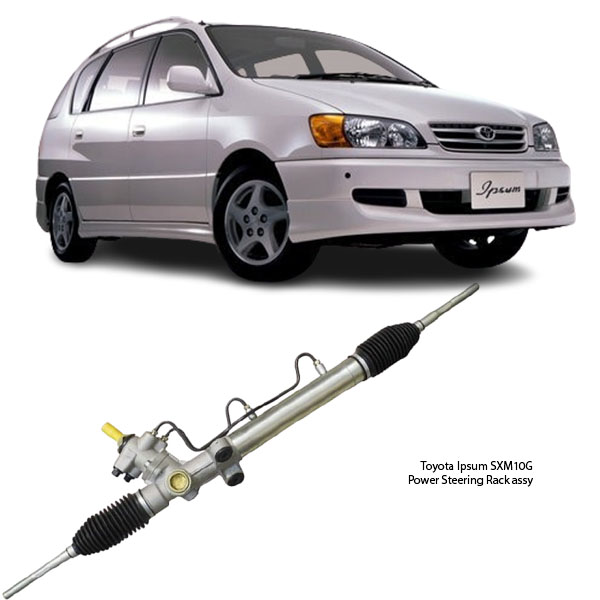-9%
Get Toyota Ipsum SXM10G RHD Hydraulic Power Steering Rack Assy 44250-44010 in Kenya
The Power Steering Rack Assembly is one of the most critical components in a vehicle’s steering system. It translates the rotational input from the steering wheel into linear movement that turns the front wheels, allowing the driver to steer the vehicle with ease. In modern vehicles, the steering rack works in conjunction with a power-assist system (hydraulic, electric, or electro-hydraulic), significantly reducing the physical effort required to steer.
Function of the Power Steering Rack Assembly
At its core, the steering rack converts the circular motion of the steering wheel into lateral motion, which moves the vehicle’s front wheels left or right. It does this using a rack and pinion mechanism — a small gear (the pinion) engages with a long, flat gear (the rack). As you turn the steering wheel, the pinion rotates, moving the rack side to side.
In power-assisted systems, this movement is supported by hydraulic pressure or an electric motor, reducing the amount of force required by the driver, especially at low speeds or when parking.
Key Components of a Power Steering Rack Assembly
A complete power steering rack assembly typically includes:
1. Steering Rack (Rack and Pinion)
- The main component responsible for converting rotational motion into linear motion.
2. Hydraulic Power Cylinder (in hydraulic systems)
- Uses pressurized fluid to assist with rack movement, reducing steering effort.
3. Tie Rods (Inner and Outer)
- Connect the steering rack to the steering knuckles attached to the wheels.
4. Seals and Boots
- Rubber boots protect the rack from dirt and debris, while seals prevent fluid leakage.
5. Steering Gear Housing
- Encloses and protects the internal rack and pinion gears.
6. Hydraulic Lines (for hydraulic power steering)
- These transport pressurized fluid between the pump and the steering rack.
Types of Power Steering Rack Assemblies
1. Hydraulic Power Steering Rack
- Uses a hydraulic pump, driven by the engine, to supply pressurized fluid to assist with steering.
- Offers a natural steering feel.
- Common in older vehicles.
2. Electric Power Steering Rack (EPS)
- Uses an electric motor mounted on the steering column or directly on the rack to assist steering.
- No hydraulic fluid is needed.
- More common in modern vehicles due to efficiency benefits.
3. Electro-Hydraulic Power Steering Rack (EHPS)
- Combines hydraulic assistance with an electric pump.
- Provides the feel of hydraulic steering with the efficiency of electric power.
How Power Steering Works
Step 1: Driver Input
When the driver turns the steering wheel, the steering column rotates the pinion gear.
Step 2: Rack Movement
The pinion gear engages the teeth of the rack, moving it left or right.
Step 3: Assisted Power
- In hydraulic systems, the rack is connected to a hydraulic piston. As the rack moves, hydraulic fluid is directed to one side of the piston, applying force to assist movement.
- In electric systems, an electric motor applies additional force directly to the rack.
Step 4: Wheel Turn
The rack’s lateral movement pushes or pulls the tie rods, which in turn rotate the steering knuckles and front wheels.
Benefits of a Well-Functioning Power Steering Rack
1. Effortless Steering
- Power assistance reduces the physical force required to steer, especially at low speeds.
2. Precise Control
- The rack and pinion mechanism offers precise, direct steering response.
3. Enhanced Safety
- Responsive steering enhances vehicle control, especially in emergency maneuvers.
4. Comfort and Convenience
- Easier maneuverability in parking lots and urban driving.
Common Symptoms of a Failing Steering Rack
1. Steering Wheel Play or Looseness
- Excessive free play in the steering wheel often indicates wear in the rack and pinion gears or tie rods.
2. Difficulty Turning
- Increased steering effort can point to fluid leaks, pump failure, or internal rack damage.
3. Noises When Steering
- Clunking, grinding, or whining noises during turns often signal a worn rack or low fluid.
4. Leaking Power Steering Fluid
- Leaks around the rack seals or hydraulic lines are a common issue in hydraulic systems.
5. Uneven Steering Response
- Steering may feel stiff in one direction and loose in the other, indicating internal rack imbalance or damage.
Causes of Power Steering Rack Failure
1. Wear and Tear
- Constant use eventually wears down gears, seals, and bearings.
2. Fluid Contamination
- Dirty or degraded power steering fluid accelerates internal wear and damages seals.
3. Leaks
- External damage or worn seals can cause fluid leaks, leading to reduced assistance.
4. Impact Damage
- Hitting curbs or potholes can bend the rack or damage tie rods.
5. Lack of Maintenance
- Ignoring recommended fluid changes or allowing leaks to persist will shorten rack lifespan.
Power Steering Rack Maintenance Tips
1. Check Fluid Regularly
- Maintain proper fluid level and condition.
- Use only the manufacturer-recommended type of fluid.
2. Inspect Boots and Seals
- Damaged rubber boots allow dirt and moisture to enter, leading to internal corrosion.
3. Address Leaks Promptly
- Even small leaks can lead to fluid loss, resulting in steering stiffness or pump damage.
4. Avoid Excessive Force
- Don’t hold the steering wheel at full lock for long periods — this stresses the system.
5. Routine Alignment Checks
- Misaligned wheels put uneven stress on the steering rack.
Repair vs. Replacement
When a power steering rack fails, you have two options:
1. Rebuild/Repair
- Some racks can be rebuilt by replacing worn seals, bearings, and gears.
- This is often cheaper but may not restore full factory performance.
2. Replace with New/Remanufactured Rack
- More expensive but ensures all components are in like-new condition.
- Recommended for severe damage or high-mileage vehicles.
Power Steering Rack Replacement Process (Overview)
- Lift the Vehicle
- Secure the vehicle on a lift for access to the rack.
- Disconnect Tie Rods
- Separate inner tie rods from the steering knuckles.
- Drain Power Steering Fluid
- Drain old fluid from the system.
- Remove Hydraulic Lines
- Disconnect fluid supply and return lines.
- Unbolt and Remove Rack
- Unfasten the rack from the vehicle chassis and slide it out.
- Install New Rack
- Reverse the process to install the new or rebuilt rack.
- Reconnect Lines and Tie Rods
- Ensure all connections are tight.
- Refill Fluid and Bleed System
- Fill with fresh fluid and remove air from the system.
- Perform Wheel Alignment
- Always align the wheels after replacing the rack.
Conclusion
The Power Steering Rack Assembly is vital for ensuring responsive, effortless steering in modern vehicles. Whether hydraulic, electric, or hybrid, it plays a direct role in vehicle handling, safety, and comfort. Regular maintenance, such as fluid checks, seal inspections, and prompt repairs, can extend its lifespan significantly.
When failure occurs, timely replacement is essential to maintain safe and enjoyable driving. For optimal performance, always choose high-quality replacement racks that meet OEM specifications.
Understanding how your power steering rack works — and how to care for it — helps keep your steering smooth and reliable for the long haul.
Follow us on Facebook for more parts.




Reviews
Clear filtersThere are no reviews yet.